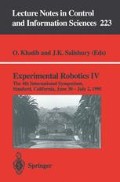Abstract
This paper discusses an artificial Active Antenna that can detect the contact location between an insensitive flexible beam and a 3D environment through the measurement of the rotational compliance of the beam in contact with the environment. The lateral slip, which possibly occurs for the 3D Active Antenna, overestimates the rotational compliance, and as a result, brings a large sensing error for the localizing contact point. The goal of this paper is to find the contact point under such conditions. In the first step, we push the antenna to the environment. If a lateral slip is confirmed, the pushing direction is changed continuously until we finally avoid the development of any lateral slip. We explore how to detect a lateral slip and how to determine the new pushing direction to avoid it. We experimentally verify an algorithm which can search the contact distance, even under the appearance of a lateral slip during the first step.
Preview
Unable to display preview. Download preview PDF.
References
Kaneko, M: Active Antenna, Proc. of the 1994 IEEE Int. Conf. on Robotics and Automation, pp2665–2671, 1994.
Kaneko, M., N. Ueno, and T. Tsuji: Active Antenna (Basic Working Principle), Proc. of the 1994 IEEE Int. Conf. on Intelligent Robotics and Systems, pp1744–1750, 1994.
Kaneko, M., N. Kanayama, and T. Tsuji: 3D Active Antenna for Contact Sensing, Proc. of the 1995 IEEE Int. Conf. on Robotics and Automation, pp1113–1119, 1995.
Russell, R. A.: Closing the sensor-computer-robot control loop, Robotics Age, April, pp15–20, 1984.
Wang, S. S. M., and P. M. Will: Sensors for computer controlled mechanical assembly, The Industrial Robot, March, pp9–18, 1978.
McKerrow, P.: Introduction to Robotics, Addison-Wesley, 1990.
Brooks, R. A.: A robot that walks; Emergent behaviors from a carefully evolved network, Neural Computation, vol.1, pp253–262, 1989.
Hirose, S., et al.: Titan III: A quadruped walking vehicle, Proc. of the Second Int. Symp. on Robotics Research, MIT Pres.
Schiebel, E. N., H. R. Busby, K. J. Waldron: Design of a mechanical proximity sensor, Robotica, vol.4, pp221–ss7, 1986.
Russell, R. A.: Using tactile whiskers to measure surface contours, Proc. of the 1992 IEEE Int. Conf. on Robotics and Automation, pp1295–1300, 1992.
Author information
Authors and Affiliations
Editor information
Rights and permissions
Copyright information
© 1997 Springer-Verlag London Limited
About this paper
Cite this paper
Kaneko, M., Kanayama, N., Tsuji, T. (1997). Experimental approach on artificial active antenna. In: Khatib, O., Salisbury, J.K. (eds) Experimental Robotics IV. Lecture Notes in Control and Information Sciences, vol 223. Springer, Berlin, Heidelberg. https://doi.org/10.1007/BFb0035213
Download citation
DOI: https://doi.org/10.1007/BFb0035213
Published:
Publisher Name: Springer, Berlin, Heidelberg
Print ISBN: 978-3-540-76133-4
Online ISBN: 978-3-540-40942-7
eBook Packages: Springer Book Archive

